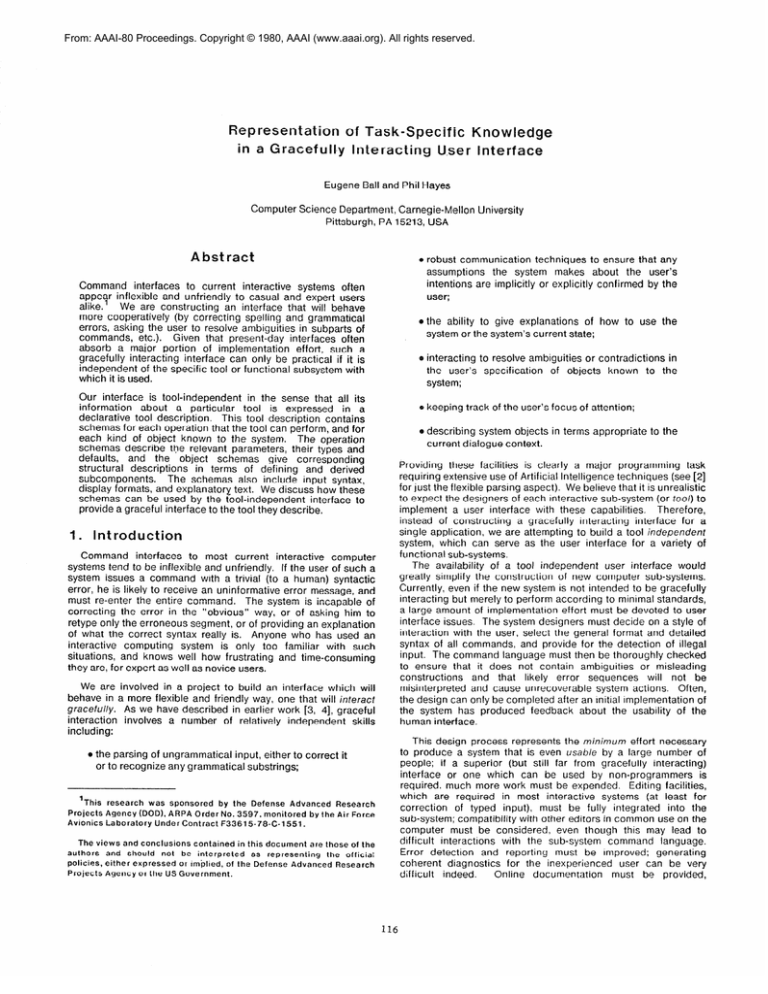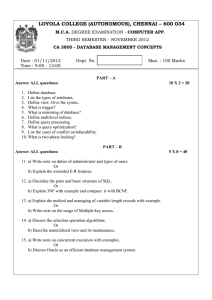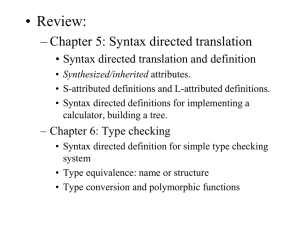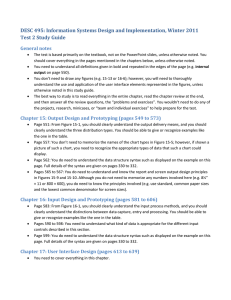
From: AAAI-80 Proceedings. Copyright © 1980, AAAI (www.aaai.org). All rights reserved.
Representation
in a Gracefully
of Task-Specific
Knowledge
Interacting
User Interface
Eugene Ball and Phil Hayes
Computer Science Department, Carnegie-Mellon
Pittsburgh, PA 15213, USA
Abstract
o robust communication techniques to ensure that any
assumptions
the system makes about the user’s
intentions are implicitly or explicitly confirmed by the
user;
Command interfaces to current interactive
systems often
appear inflexible and unfriendly to casual and expert users
alike.’
We are constructing
an interface that will behave
more cooperatively
(by correcting spelling and grammatical
errors, asking the user to resolve ambiguities in subparts of
commands, etc.).
Given that present-day interfaces often
absorb a major portion of implementation
effort, such a
gracefully interacting interface can only be practical if it is
independent of the specific tool or functional subsystem with
which it is used.
o the ability to give explanations
of how to use the
system or the system’s current state;
e interacting to resolve ambiguities or contradictions
in
the user’s specification
of objects known to the
system;
Our interface is tool-independent
in the sense that all its
information
about a particular
tool is expressed
in a
declarative tool description.
This tool description contains
schemas for each operation that the tool can perform, and for
each kind of object known to the system.
The operation
schemas describe tne relevant parameters, their types and
defaults,
and the object schemas
give corresponding
structural
descriptions
in terms of defining and derived
subcomponents.
The schemas also include input syntax,
display formats, and explanatory text. We discuss how these
schemas can be used by the tool-independent
interface to
provide a graceful interface to the tool they describe,
1.
o keeping track of the user’s focus of attention;
e describing system objects in terms appropriate
current dialogue context.
Command interfaces to most current interactive
computer
systems tend to be inflexible and unfriendly.
If the user of such a
system issues a command with a trivial (to a human) syntactic
error, he is likely to receive an uninformative error message, and
must re-enter the entire command.
The system is incapable of
correcting the error in the “obvious” way, or of asking him to
retype only the erroneous segment, or of providing an explanation
of what the correct syntax really is. Anyone who has used an
interactive
computing
system is only too familiar with such
situations, and knows well how frustrating and time-consuming
they are, for expert as well as novice users.
We are involved in a project to build an interface which will
behave in a more flexible and friendly way, one that will inferact
graceful/y.
As we have described in earlier work [3, 41, graceful
interaction
involves a number of relatively independent
skills
including:
This design process represents the minimum effort necessary
to produce a system that is even usable by a large number of
people; if a superior (but still far from gracefully interacting)
interface or one which can be used by non-programmers
is
required. much more work must be expended.
Editing facilities,
which are required in most interactive
systems (at least for
correction
of typed input), must be fully integrated
into the
sub-system; compatibility with other editors in common use on the
computer must be considered, even though this may lead to
difficult interactions
with the sub-system command language.
Error detection
and reporting must be Improved; generating
coherent diagnostics for the inexperienced
user can be very
difficult
indeed.
Online documentation
must be provided,
mthe parsing of ungrammatical input, either to correct it
or to recognize any grammatical substrings;
1This
research
was
Agency
Avionics
Laboratory
The views
sponsored
(DOD),
ARPA
Under
Contract
and conclusions
authors
and
should
policies,
either
Projects
Agency
not
expressed
by
Order
the
in this
interpreted
OI Implied,
Advanced
monitored
Research
by the Air Force
F33615-78-C-1551.
contained
be
Defense
No. 3597,
of the
as
document
are those
representing
Defense
Advanced
the
to the
Providing these facilities is clearly a major programming
task
requiring extensive use of Artificial Intelligence techniques (see [2]
for just the flexible parsing aspect). We believe that it is unrealistic
to expect the designers of each interactive sub-system (or tool) to
Therefore,
implement a user interface with these capabilities.
instead of constructing
a gracefully interacting interface for a
single application, we are attempting to build a tool independent
system, which can serve as the user interface for a variety of
functional sub-systems.
The availability of a tool independent
user interface would
greatly simplify the construction
of new computer sub-systems.
Currently, even if the new system is not intended to be gracefully
interacting but merely to perform according to minimal standards,
a large amount of implementatron effort must be devoted to user
interface issues. The system designers must decide on a style of
interaction with the user, select the general format and detailed
syntax of all commands, and provide for the de.tection of illegal
input. The command language must then be thoroughly checked
to ensure that it does not contain ambiguities or misleading
constructions
and that likely error sequences
will not be
misinterpreted and cause unrecoverable system actions.
Often,
the design can only be completed after an Initial implementation of
the system has produced feedback about the usability of the
human interface.
Introduction
Projects
University
of the
official
Research
or the US Government.
116
completely
specified
by the declarative
tool
description.
Communication between the Agent and the user is not direct, but
goes via a device-dependent
Front-End,
which allows the Agent to
specify its output in a high-level device-Independent
manner, and
which
preprocesses
the
user’s
input
into
a standard,
device-independent,
format. Communication between the Agent
and Front-End is thus restricted to a well-defined format of input
and output requests. Display formats in which to realize the tool’s
and Agent’s high-level output requests are specified declaratively
in the tool description.
including reasonable facilities which allow a user to quickly find
the answer to specific (although vaguely expressed) questions.
The complexity
of this task often means that most of the
implementation effort in adding a new tool to a computer system is
absorbed by the user interface.
Technological trends are aggravating the problem by raising
the level of performance expected of an interface. In particular, as
high-resolution graphics displays equipped with pointing devices
become available, users expect to use menu-selection and other
more sophisticated
forms of input, and to see system output
displayed in an attractive graphical format. The very recent, but
growing, availability of speech input and output will intensify this
pressure for sophistication.
The basic function of the Agent is to establish from the user’s
input what functional capability of the tool the user wishes to
invoke and with what parameters he wishes to invoke it. Once this
is established, the Agent issues the appropriate request to the tool
and reports to the user relevant portions of the tool’s response.
To make this possible, the tool description includes a specification
of all the operations
provided by the tool in terms of their
parameters and their types, defaults, etc., plus specifications of all
the abstract objects manipulated by the tool in terms of their
defining (and descriptive) sub-components.
This representation
of operations and objects follows Minsky’s frames paradigm [7] in
the spirit of KRL [l] or FRL [13]. The representation allows the
Agent to follow the user’s focus of attention down to arbitrarily
deeply nested aspects of object or operation descriptions
to
resolve ambiguities or contradictions.
This facility depends on the
tool to provide resolution of object descriptions
into sets of
referents.
An additional
reason for constructing
a tool-independent
interface is to make the computer system as a whole appear
consistent to the user. If the interfaces for different tools use
different conventions, then no matter how sophisticated each of
them is individually. the user is likely to be confused as he moves
from one to another because the expectations raised by one may
not be filled by the other.
For all these reasons, we are attempting to make our gracefully
interacting
interface as tool-independent
as possible.
In the
remainder of this paper we outline the system structure we have
developed, and go on to give further details about one component
of this structure, the declarative format in which information about
the tool is made available to the interface, together with sketches
of how the tool-independent
part of the system uses the
information thus represented.
2.
System
The tool description also specifies the syntax for the user’s
input descriptions
of the objects and operations.
The Agent
applies the grammar thus specified to the user’s input (as
pre-processed by the Front-End) in a flexible way, providing the
kinds of flexible parsing facilities mentioned above. The user may
also request information about the tool or other help, and the
Agent will attempt to answer the query with information extracted
from
the
tool
description,
and displayed
according
to
tool-independent
rules.
Structure
The basis for our system structure is the requirement that the
interface
contain
no tool-dependent
information.
All such
information must be contained in a declarative data base called
the tool description.
In an effort further to improve portability and
reduce duplication of effort between interfaces implemented on
different hardware configurations,
we have made a second major
separation between the device-dependent
and -independent parts
of the interface. The resulting structure is illustrated in figure 1.
Besides requesting that the Front-End output text strings to the
user, the Agent may also specify instances of system objects. The
Front-End will then drsplay the objects according to a display
format specified in the tool description.
For the Front-End we are
using, whrch operates through a graphics display equipped with a
pointing device. this allows the user to refer directly to system
objects by pointing. The Front-End reports such pointing events
to the Agent in terms of the system object refered to. Typed input
is pre-processed into a stream of lexical items, and other pointing
events, such as to menus, can also be reported as lexical items.
We are also experimenting with a limited-vocabulary,
single word
(or phrase) speech recognizer, isolated in the Front-End.
It’s
output can also be reported as a lexical item.
This concludes the overview of the system structure.
For the
remainder of the paper, we will concentrate on the representation
employed in the tool-description,
and the way the information,
thus represented, is used by the remainder of the system. Our
examples will be in terms of the tool being used as a test-bed for
the development
of the Agent and Front-End:
a multi-media
message system, capable of transmitting,
receiving, filing, and
retrieving pieces of electronic mail whose bodies contain mixtures
of text, speech, graphics, and fax.
User
Agent
3.
Figure
1. User Interface
System
Structure
Representation
information
of task specific
A functional sub-system, or tool, is characterized for the user
interface program by a data base which describes the objects it
manipulates and the operations
it can perform.
This fool
description
is a static information
structure (provided by the
sub-system implementor) which specrfies everything that lhe User
The intelligent functions of the interface, those itemized above,
are isolated in a tool and device independent User Agenf, which
interacts
with the tool through
a narrow interface
that is
117
Agent needs to know about the tool.
We’ll first give a brief
overview of the structure of the tool description and how the Agent
uses it to provide an interface to the sub-system. Then the content
of the data base will be explained in more detail, with examples
showing how this information
is utilized in the processing of
commands from the human user. The tool description consists of:
o Declarations
of the data objects
used by the
tool.
These declarations specify the internal structure of
a particular
each
object
type
defined
within
sub-system.
The tool may also contain references to
object types that are defined in a global data base and
are used by many different tools (e.g. files, user
names, dates and times).
The object declaration
provides rules for displaying an instance of the object,
syntax for descriptions
of it in commands,
and
documentation that can be used to explain its function
to the user.
AMPM: AM
Hour: 11 Minutes: 16 Seconds: 371
Subject: “Meeting tomorrow?”
Body: “Phil, Could we meet tommorrow at 1pm? -Gene”
1
The structure of a Message is defined in the tool data base by
a message schema. This schema declares each legal field in the
object and its type, which may be a primitive type like TEXT or an
object type defined by another schema in the tool description.
The schema also specifies the number of values that each field
may have, and may declare default values for new instances of the
object. The following is a simplified schema for a message object
and some of its components:
StructureType: ObjectSchema
ObjectName: Message
DescriptionEvaluation:
ToolKnows
Schema:
Sender: [ FillerType: Mailbox ]
Recipient:
[ FillerType: Mailbox Number: OneOrMore ]
Copies: [ FillerType: Mailbox
Number: NoneOrMore ]
Date: [ FillerType: Date ]
Subject: [ FillerType: MultiMediaDocument
]
Body: [ FillerType: MultiMediaDocument
]
After: [ FillerType: Date UseAs: DescriptionOnly ]
Before: [ FillerType: Date UseAs: DescriptionOnly ]
o Descriptions
of the operations
which the tool
can perform.
Each operation entry specifies the parameters that the
Agent must provide to the tool to invoke that action. It
also defines the legal syntax for the command,
provides some simple measures of its cost and
reversability,
and supplies a text explanation
of its
purpose.
StructureType: ObjectSchema
ObjectName: Mailbox
DescriptionEvaluation:
ToolKnows
Schema:
[ PersonName:
[ FillerType: PersonName ]
Host: [ FillerType: Host ]
As mentioned earlier, the primary goal of the Agent is to help
the human user to specify sub-system operations to be executed.
To carry out this function,
it parses the user’s commands
(including text, pointing, and possibly spoken input) according to
11
StructureType: ObjectSchema
ObjectName: PersonName
DescriptionEvaluation:
OpenEnded
Schema:
[ First: [ FillerType: TEXT ]
Middle: [ FillerType: TEXT Number: NoneOrMore]
Last: [ FillerType: TEXT ]
the syntax specifications in the tool description.
It decides which
operation has been selected and attempts to fill out the parameter
template associated with it. This process may involve interpreting
descriptions
of sub-system objects, negotiating
with the user
about errors or ambiguities that are discovered, and explaining the
meaning of command options,
3.1.
Object
II
Descriptions
The tool description contains a declaration of each data type
that is defined within that sub-system. Data objects which will be
manipulated by both the Agent and the tool are represented as
lists and property lists (sets of name-value pairs), using the
formalism defined by Postel for the communication
of Internet
messages [9]. This representation
is self-describing
in that the
structure and type of each data element is represented explicity in
the object. Thus, complexly structured objects can be transferred
between the User Agent and the tool, and the Agent can interpret
them according
to the information
contained
in the tool
description.
For example,
the following
is the internal
representation
of a simple message (primitive elements are
integers or text strings, and brackets are used to delimit sets of
name-value pairs):
[
StructureType: Objectlnstance
ObjectName: Message
Sender:
[ PersonName: [ First: John Middle: Eugene Last: Bali]
Host: [ Site: CMU Machine: A ]
1
Recipient:
[ PersonName:
[ First: Phil Last: Hayes ]
Host: [ Site: CMU Machine: A ]
1
Copies: []
Date: [ Year:1980
Month:April
Day:10 Weekday:Thursday
StructureType: ObjectSchema
ObjectName:
DescriptionEvaluation:
ToolKnows
Schema:
[ Site: [ FillerType: TEXT Default: CMU ]
Machine:
[ FillerType: TEXT Default: A ]
Host
11
In addition to defining the structure of an instance of a message
object, the schema includes fields which are used by the Agent to
interpret descriptions of messages. The DescriptionEvaluation
field tells the Agent how to evaluate a description of an object in
For example,
ToolKnows
indicates
that the
this class.
sub-system is prepared to evaluate a description
structure
and
return a list of instances matching the description.
A description
structure is an instance of the object with special wild card values
for some fields and with possible extra DescriptionOnly
entries,
such as the After field in the example above. Since a description
of one object may reference other objects (“the messages from
members of the GI project”), the Agent uses the hierarchy defined
by the object declarations to guide its evaluation of the user’s
commands.
Each level generates a new sub-task in the Agent
which processes that portion of the description, and is responsible
for resolving ambiguities that it may encounter. This structure also
makes it possible to follow the user’s focus of attention, since new
input may apply to any of the currently active subgoals (“No, only
the ones since October” or “No, only the ones at ISI”).
118
information network at a node representing the data type, which is
connected to Zog frames for other objects referenced by that type.
The user can find information about a related sub-system object
by choosing a link to follow (with a menu selection); that frame is
quickly displayed.
The legal syntax for descriptions of the object
and links to frames for operations which manipulate it are also
included
in the Zog network.
In the following
example
documentation
frame for Message,
the italicized entries are
buttons which can be activated to request more information about
a specific topic:
Each object declaration also includes information which is used
by the Front-End module to display instances of that object type.
Several different formats may be defined; the tool (or Agent)
selects an appropriate format by name each time it displays an
object. The format declaration specifies which fields of the object
to display and their layout; it may also provide parameters to the
Front-End which invoke special capabilities (highlighting,
font
selection) of the display hardware.
For example, the following
section of the description for a Message
defines two different
styles of message header display.
Messase:
DisplayFormat:
[ ShortHeader:
// style: From Hayes on 18-Mar
[ Text: “From &Sndr& on &Day&”
Sndr: [Field: Sender/PersonName/Last
FaceCode: Bold]
Day: [ Field: Date Style: ShortDay ]
(Multi-Media
Message System)
Each message contains
the author and date of
origination
and is addressed
to (one or more)
destination mailboxes; copies may optionally be sent to
additional destinations.
The body of a message may
contain uninterpreted text, images, sketches, and voice
recordings.
1
FullHeader:
// From Eugene Ball on lo-Apr-80 11:16am
about ‘Meeting tommorrow?
[ Text: “From &Sndr& on &Day& about ‘&Subj&“’
Sndr: [ Field: SenderIPersonName
Style: FullName ]
Day: [ Field: Date Style: FullDate ]
Subj: [ Field: Subject
Style: FullSubj ]
Example syntax:
‘messages [from Person] [before/after
[about String]’
Detailed
11
syntax
Operations:
Related object types:
Each object declaration also defines the legal syntax that can
be used in commands that refer to objects of that type. In order to
understand a phrase like “the messages from Phil since March”,
the Agent uses the syntax definition associated with the object
type Message, which in turn refers to the syntax for other objects
like Date and PersonName.
In the example below, question
marks indicate optronal syntactic elements, asterisks mark fields
that can be repeated, slashes indicate word class identifiers, and
ampersands mark places where the syntax for other object types is
to be expanded.
Some syntactic
entries
also specify
correspondences
to particular fields in the object; as a command
is parsed, the Agent builds description
structures
which represent
the objects referred to in the command. Thus, the phrase “since
March” results in an appropriate After clause in the Message
description.
The grammar defined by these syntax entries is
applied to the user’s input in a flexible way [2], so that grammatical
deviations such as misspellings, words run together, fragmentary
input, etc. can still be parsed correctly.
Mailbox
Display
3.2.
Date]
Multi Media
Operation
Document
Send Date
Edit
Descriptions
Each sub-system operation
is also described by an entry
entry specifies the parameters
tool to have it perform that
which can be invoked by the Agent
in the tool data base. An operation
that the Agent must provide to the
action.
The object type of each
parameter is declared and the tool description can optionally
indicate that a parameter position may be filled by a set of such
objects. In addition, constraints on the legal values of a parameter
are sometimes provided, which can help the Agent to avoid
requesting an illegal operation.
[
Syntax:
[
Pattern: (?/Determiner /MessageHead
*/MessageCase)
Determiner:
(the (all ?of ?the) every)
MessageHead:
(messages notes letters mail)
MessageCase:
( [ Syntax: (/From &Mailbox)
StructureToAdd:
[ Sender: &Mailbox ]]
[ Syntax: (/Before &Date)
StructureToAdd:
[ Before: &Date]]
[Syntax:
(/After &Date)
StructureToAdd:
[ After: &Date ]]
StructureType: Operation
OperationName: Forward
Reversible: false
Cost: moderate
Parameters:
[ Message: [ FillerType: Message Number: OneOrMore ]
Recipient:
[ FillerType: Mailbox Number: OneOrMore ]
Forwarder:
[ FillerType: Mailbox MustBe: CurrentUser ]
1
Syntax:
[ Pattern: (/Forward %Message to %Recipient)
Forward: (forward send mail (pass on) deliver redeliver)
1
Explanation: “Message Forwarding
A copy of a message that was delivered to you can be sent to
another person with the Forward command. You must specify
the message to forward and the destination mailbox. Sample
syntax: ‘Forward the last message from Phil to Adams at ISIE”’
1
From: (from (arriving from) (that came from) (/Mailed by))
Mailed: (mailed sent delivered)
Before: (before (dated before) (that arrived before))
After: (after since (dated after))
The example entry for the forward operation also mcludes a
declaration of the legal syntax for the command, and a text entry
which will be included in its documentation frame. It also indicates
that this command is not reversible (once executed it cannot be
undone), and that it is moderately expensive to execute.
This
information is used by the Agent to select an appropriate style of
interaction with the User; for example, irreversible operations will
usually require explicit confirmation before the request is given to
the sub-system for execution.
1
Finally, the object description provides information which is
used to automatically
construct
documentation
and provide
answers to user requests for help. Each object contains a brief
text explanation of its structure and purpose in the sub-system,
which can be presented to the user in response to a request for
information.
The documentation
is also placed into a Zog [14]
119
4.
References
Conclusion
The design and implementation of a good user interface for a
computer sub-system is a difficult and time-consuming
task; as
new techniques for communication
with computers (especially
high resolution displays and speech) gain widespread use, we
expect this task to become even more expensive.
However, we
also feel that the typical user interface must be made much more
For this goal to be feasible,
robust, graceful, and intelligent.
substantial portions of the interaction with the user must be
independent
of the details of the application,
so that the
development cost of the user interface code can be shared by
many sub-systems.
Therefore, we are designing a generalized User Agent which
can be used to control a variety of different sub-systems.
The
Agent carries on a dialog with the human user; it can understand a
variety of different command styles, recognize and correct minor
syntactic or spelling errors, supply default values for command
arguments based on context, and provide explanations
when
requested.
All of the information that the Agent needs to know
about the application
system is explicitly
stored in a tool
description
provided by the sub-system implementor.
This paper
has concentrated on the content of that data base, detailing the
information represented there and demonstrating
how the Agent
can apply it to provide a sophisticated
interface to a specific
application system.
The tool description
is represented in a unified formalism,
which enables us to maintain a single data base which specifies all
of the task-specific attributes of a particular sub-system. Because
the information is stored in a single format, it can easily be utilized
by multiple portions of the interface system. For example, a single
syntax description is used to parse user commands, to generate
explanations of system actions, and to construct documentation Of
the options available in the tool.
The initial implementation
of the Agent will provide the user
interface for the Multi-Media Message System; an electronic mail
facility which manipulates messages containing mixtures of text,
recorded speech, graphics, and images.
The system is being
implemented as a multiple machine, multiple language distributed
system:
screen management (multiple windows) and graphics
support are provided in Bcpl [l I] on a Xerox Alto [15] with a high
resolution raster display and pointing device: audio recording and
playback is controlled by a DEC PDP-11 in C [5]; the Front-End
module and User Agent are implemented
in C and LISP
respectively,
on a VAX-l l/780 running Unix [12]; and the tool
(message system) runs in C on the VAX. The system modules
communicate
using
a
Inter-Process
message
based
Communication
facility [lo] within Unix, and a packet broadcast
network (Xerox Ethernet [6]) between machines.
Most of the
system components are currently running as individual modules,
the first version of a single integrated system should be completed
by June 1980. Because of our goal of a smoothly working, robust,
and graceful system, we expect to continue tuning and improving
the implementation
for at least another year.
The system will
eventually be moved to a single powerful personal computer,
where we expect it to make substantial contributions to the CMU
Spice (Scientifc Personal Integrated Computing Environment [8])
development effort.
1.
Bobrow, D. G. and Winograd, T. “An Overview of KRL-0, a
Language.” Cognitive Science 1,1
Knowl&geRepresentation
(1977).
PrOC. of
Hayes, P. J. and Mouradian, G. V. Flexible Parsing.
2.
18th Annual Meeting of the Assoc. for Comput. Ling., Philadelphia,
June, 1980.
3.
Hayes, P. J., and Reddy, R. Graceful Interaction in
Man-Machine Communication.
Proc. Sixth Int. Jt. Conf. on
Artificial Intelligence, Tokyo, 1979, pp. 372-374.
Hayes, P. J., and Reddy, R. An Anatomy of Graceful
4Interaction in Man-Machine Communication.
Tech. report,
Computer Science Department, Carnegie-Mellon University,
5.
Kernighan,
Programming
1979.
Brian W. and Ritchie, Dennis M. The C
Prentice-Hall, Inc., 1978.
Language.
6.
Metcalf, Robert and Boggs, David. “Ethernet: Distributed
Packet Switching for Local Computer Networks.” Comm. ACM 79,
7 (July 1976), 395404.
7.
Minsky, M. A Framework for Representing Knowledge. In
McGraw Hill,
Winston, P., Ed., The Psychology of Computer-Vision,
1975, pp. 211-277.
8.
Newell, A., Fahlman, S., and Sproull, R.F. Proposal for a joint
effort in personal scientific computing. Tech. Rept. , Computer
Science Department, Carnegie-Mellon University, August, 1979.
9.
Postel, J. Internet Message Protocol. Draft Internet
Experiment Note, Information Sciences Institute, Univ. of
Southern California, April, 1980.
Rashid, R. A proposed DARPA standard inter-process
locommunication facility for UNIX version seven. Tech. Rept. ,
Computer Science Department, Carnegie-Mellon University,
February, 1980.
1 1 - Richards, M. BCPL: A tool for compiler writing and systems
programming.
Proceedings of the Spring Joint Computer
Conference, AFIPS, May, 1969, pp. 34557-566.
12.
Ritchie, D. M. and Thompson, K. “The UNIX Time-Sharing
System.“ Comm. ACM 77, 7 (July 1974), 365375.
13.
Roberts, R. B. and Goldstein, I. P. The FRL Manual.
Memo 409, MIT Al Lab, Cambridge, Mass., 1977.
A. I.
14.
Robertson, G., Newell, A., and Ramakrishna, K. ZOG: A
Man-Machine Communication Philosophy. Tech. Rept. ,
Carnegie-Mellon University Computer Science Department,
August, 1977.
16
. Thacker, C.P., McCreight, E.M., Lampson, B.W., Sproull,
R.F., and Boggs, D.R. Alto: A personal computer. In Computer
Structures:
Readings
and Examples,
McGraw-Hill, 1980. Edited by
D. Siewiorek, C.G. Bell, and A. Newell, second edition, in press.
120








